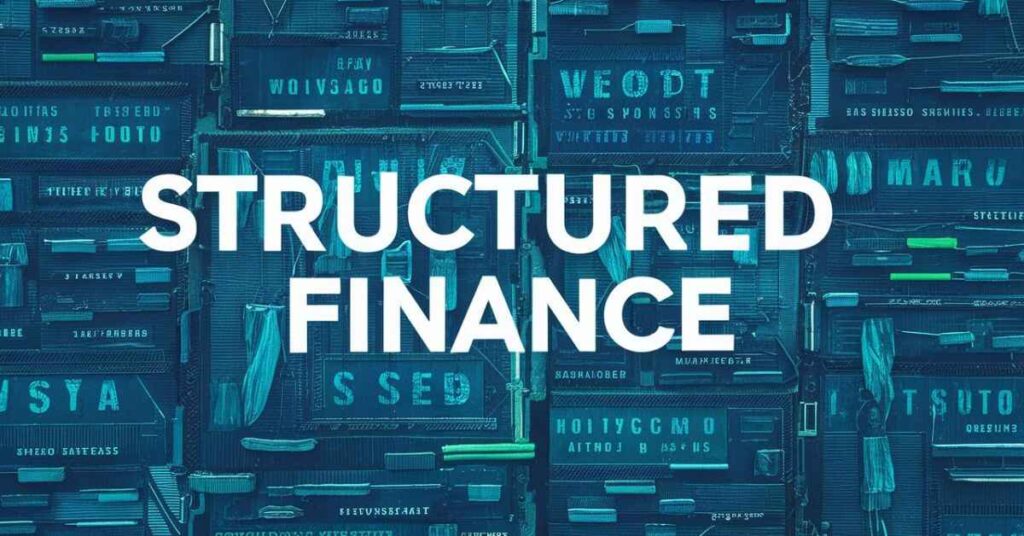Ever wondered how big companies manage to raise billions of dollars for massive projects? Or how banks package and sell mortgages to investors? Welcome to the fascinating world of structured finance! This financial wizardry has reshaped global markets, offering new ways to manage risk and unlock value. But what exactly is structured finance, and why should you care? Let’s dive in and demystify this complex but crucial aspect of modern finance. what is structured finance?
What Do You Mean by Structured Finance?
Structured finance isn’t your run-of-the-mill financial transaction. It’s like financial Lego – taking basic financial assets and reengineering them into complex instruments tailored to specific needs. At its core, finance involves:
- Pooling assets
- Repackaging them into interest-bearing securities
- Selling these securities to investors
Think of it as financial alchemy, turning lead into gold. Except here, we’re turning illiquid assets into tradable securities. Cool, right?
Structured finance emerged in the 1970s with the birth of mortgage-backed securities. Since then, it’s exploded in complexity and scope, becoming a cornerstone of modern finance. Why? Because it allows companies and financial institutions to transfer risk, increase liquidity, and access new sources of funding.
What’s the Difference Between Corporate Finance and Structured Finance?
You might be thinking, “Isn’t this just fancy corporate finance?” Not quite. Let’s break it down:
| Corporate Finance | Structured Finance |
|---|---|
| Focuses on a company’s balance sheet | Focuses on a pool of assets |
| Typically simpler transactions | Complex, often involving multiple parties |
| Risk tied to company performance | Risk distributed among various investors |
| Straightforward funding methods (e.g., bonds, equity) | Creates new securities from existing assets |
Corporate finance is like managing your personal bank account. Structured is more like running a complex lemonade stand franchise. Both deal with money, but the scale and complexity are worlds apart.
Understanding Structured Finance

Now, let’s roll up our sleeves and get into the nitty-gritty. finance is all about creating new securities from a pool of assets. Here’s how it typically works:
- Origination: A company (the originator) identifies a pool of assets it wants to monetize.
- Special Purpose Vehicle (SPV) Creation: The originator creates a separate legal entity called an SPV.
- Asset Transfer: The assets are sold to the SPV.
- Securitization: The SPV issues securities backed by these assets.
- Credit Enhancement: Various methods are used to improve the credit rating of the securities.
- Sale to Investors: The securities are sold to investors.
It’s like a financial assembly line, each step adding value and complexity to the final product.
| “Structured finance is the financial equivalent of splitting the atom. It releases enormous amounts of energy, but it needs to be handled with care.” – Warren Buffett |
Benefits of Structured Finance
Why go through all this trouble? Well, structured offers some juicy benefits:
For issuers:
- Off-balance-sheet financing
- Access to cheaper funding
- Risk transfer
For investors:
- Higher yields
- Customized risk-return profiles
- Portfolio diversification
Behind the economy:
- Increased liquidity in financial markets
- More efficient allocation of capital
- Spread of risk across the financial system
It’s a win-win-win situation… when done right.
Examples of Structured Finance Products
Let’s get concrete. Here are some common finance products you might encounter:
- Mortgage-Backed Securities (MBS): Remember the 2008 financial crisis? These were the stars of the show. MBS are created by pooling mortgages and selling shares to investors.
- Collateralized Debt Obligations (CDOs): These bad boys take it up a notch, pooling various debt instruments like bonds, loans, and even other securities.
- Asset-Backed Securities (ABS): Similar to MBS, but backed by assets like car loans, credit card debt, or even music royalties. (Fun fact: David Bowie once issued “Bowie Bonds” backed by his music royalties!)
- Credit Default Swaps (CDS): These are like insurance policies for bonds. Investors pay a premium to protect against default.
Each of these products has its quirks and complexities. It’s like a financial zoo, each species with its unique characteristics and behaviors.
What Does Structured Finance Involve?
Structured finance isn’t for the faint of heart. It involves:
- Complex financial modeling
- Legal structuring
- Risk assessment and management
- Regulatory compliance
- Marketing to investors
It’s a team sport, requiring collaboration between bankers, lawyers, accountants, and risk managers. Think of it as the financial equivalent of building a spacecraft – lots of moving parts, all needing to work together perfectly.
What Is Structured Finance Used for?
Structured finance isn’t just a Wall Street plaything. It has real-world applications:
- Infrastructure Financing: Building that new highway? Structured finance can help raise the funds.
- Corporate Funding: Companies can monetize future cash flows, like credit card receivables.
- Risk Management: Banks use structured finance to manage their loan portfolios.
- Real Estate Development: Large-scale projects often rely on structured finance solutions.
Case Study: Green Bond Financing
In 2019, Verizon issued a $1 billion green bond to fund renewable energy projects. This structured solution allowed Verizon to tap into the growing market for environmentally conscious investments while financing its sustainability goals.
What Are Structured Finance Product Types?
We’ve covered some examples, but let’s dive deeper into the types of structured finance products:
- Asset-Backed Securities (ABS)
- Auto loan ABS
- Credit card ABS
- Student loan ABS
- Mortgage-backed securities (MBS)
- Residential MBS
- Commercial MBS
- Collateralized Debt Obligations (CDOs)
- Cash CDOs
- Synthetic CDOs
- Credit Derivatives
- Credit Default Swaps (CDS)
- Total Return Swaps
Each type has its risk-return profile, like different flavors of financial ice cream. Some are vanilla, others are triple chocolate fudge with sprinkles.
What is Structured Finance in Investment Banking?
In investment banking, finance is where the magic happens. It’s a key revenue generator and a hotbed of innovation. Investment banks:
- Design and create structured products
- Underwrite and distribute securities
- Provide advisory services on structured finance deals
For ambitious finance grads, structured finance offers a challenging and potentially lucrative career path. It’s where financial engineering meets deal-making, requiring a mix of quantitative skills and business acumen.
What is Structured Finance Law?
With great complexity comes great legal scrutiny. Finance law is a specialized field dealing with:
- Securities regulations
- Tax implications
- Bankruptcy remoteness
- Regulatory compliance
Key regulations include:
- Dodd-Frank Act (USA)
- European Market Infrastructure Regulation (EU)
- Basel III Accord (Global)
These laws aim to prevent abuses and ensure stability in the financial system. After all, we don’t want a repeat of 2008, do we?
conclusion
In conclusion, structured is a powerful tool in the modern financial landscape. It’s complex, sometimes controversial, but undeniably important. Whether you’re a finance pro or just a curious observer, understanding finance gives you valuable insight into how money moves in our global economy.
Remember, with great financial power comes great responsibility. Use structure wisely, and it can unlock tremendous value. Misuse it, and well… let’s just say we’ve all seen that movie before.
FAQs
Ans: While it can offer attractive returns, structured finance products can be complex and risky. Always do your homework.
Ans: Misuse of mortgage-backed securities and CDOs played a significant role. It’s a cautionary tale about the dangers of financial innovation without proper oversight.
Ans: Strong math skills, financial modeling expertise, and a good understanding of law and regulations are essential. Oh, and a healthy dose of creativity doesn’t hurt.
Ans: Blockchain and AI are revolutionizing the field, making transactions faster, more transparent, and potentially more secure.
Ans: Despite past controversies, finance continues to evolve and grow. New applications in areas like renewable energy financing and infrastructure development are emerging.





